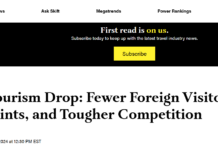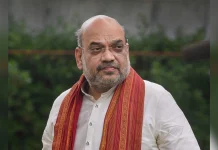The recently inked pacts with north eastern states are not only humane but will also take care of the security and sovereignty of the country.
By Rajesh Singh
Two important agreements were inked in recent days, and they are expected to usher in lasting peace and prosperity in the North-East. Not surprisingly, the electronic media by and large, obsessed with the ongoing furore over the Citizenship (Amendment) Act of 2019, did not give the development the attention it deserved. Both these pacts have ended decades-long disputes, and while some apprehensions still remain, they can be resolved in the new environment of give-and-take. The agreements are not only humane but also take care of the security and sovereignty of the country.
The first deal is for the settlement of the Bru-Reang people in Tripura. For 23 long years, more than 30,000 members of this community lived as refugees in relief camps there, having fled their homes in Mizoram in the wake of ethnic clashes. More than half of the community’s people had left Mizoram following violent confrontations with sections of the Mizo people. The Bru community is spread across Tripura, Mizoram and parts of southern Assam. Now the most populous tribe in Tripura, it is ethically different from the Mizo community, with its own language and customs. The Bru people are one of the more than 20 ethnic tribes of Tripura. The violence and subsequent displacement had led to demands for an autonomous district council for the Bru-Reang people under the Sixth Schedule of the Constitution.
Several attempts had been in the past made to resolve the crisis. Since 2010, the governments of Tripura and Mizoram tried to find a solution. Although in 2018, the government had offered the community a peaceful return to Mizoram, fewer than 330 families opted to go back, because the situation there was still uncertain in the absence of an agreement that was acceptable to the militant Mizo and the Bru-Reang communities. The new agreement involves all the stakeholders — the governments of Mizoram and Tripura, the Centre and representatives of the community — and paves the way for the safe rehabilitation of those refugees in Tripura who wish to stay back. For those who desire to return to Mizoram, the environment would now be conducive for them. Administrative measures will be taken for the settlers, such as a physical verification of the refugees and a survey to determine their needs for a dignified living. Besides, land will be identified for the settlers. While the Centre has already announced the release of Rs. 600 crore for their needs, it will also work out a special package that will supplement that amount. Each resettled family will be given a fixed area of land to build a home (a housing assistance amount will also be made available, though the State government will build the homes and hand over possession to the beneficiaries), and a one-time cash assistance of four lakh rupees will also be extended. Land will be allotted from government property, though private land would also be acquired since the government may fall short of the land at its disposal. However, Bru-Reang people who had returned to Mizoram as part of a repatriation drive conducted in eight phases since 2009, will not be considered for settlement in Tripura. The Bru-Reang members are considered a ‘particularly vulnerable tribal group’ (PVTG) in Tripura. Most of them had fled Mizoram after being targeted by organisations such as the Young Mizo Association and a few other ethnic outfits.
A great deal of backroom discussions took place before the historic agreement was sealed. A member of Tripura’s erstwhile royal family had written to Union Minister for Home Affairs Amit Shah in November 2019, favouring resettlement. This was followed by Chief Minister Biplab Deb too seeking the resettlement. Tripura had no problems with the resettlement as, after all, the Bru-Reang people originally belong to that State; they had moved over to Mizoram after their land and homes were flooded with the commissioning of a hydroelectric power plant in 1976.
The second equally historic agreement promises to bring the curtains down on the decades-old confrontation between the Bodo population and the non-Bodo people in Assam. Though some non-Bodo leaders have expressed skepticism over the accord, these remarks are more as a result of local politics. All four major factions of the National Democratic Front of Bodoland (NDFB), the All Bodo Students Union (ABSU) and the United Bodo People’s Organisation (UBPO) were among the signatories to the understanding. The agreement was inked in the presence of Amit Shah, the Assam Chief Minister and some of his senior colleagues. This is the first time that all the stakeholders came on a common platform. The significance of this deal is that the armed struggle for a separate Bodo State comes to an end. In return, the governments, under the deal, will protect and promote the unique identity of the Bodo population and work towards the community’s all-round development and integration into the larger community.
More than 4,000 people lost their lives over the last decades in the violent conflicts between the Bodo and the non-Bodo peoples. The resulting unrest also had an adverse impact on the development of Assam and neighbouring regions in the North-East. The agreement, among other things, allows for armed militant groups now part of the accord, to lay down their arms and join the mainstream. The government has announced an economic package of Rs. 1,500 crore (to be shared equally between the Centre and the State) for the Bodo community. Besides, the existing Bodoland Territorial Council (BTC) comprising four districts of the State will be given additional powers. There will also be some shuffling of the population — a commission will be set up to determine the inclusion of more regions in the Council and exclusion of those that are not dominated by the Bodo population. The BTC will be renamed as Bodoland Territorial Region to give greater meaning to their status.
The new agreement is expected to bring peace that eluded two earlier pacts. The first had been signed in 1993 with the ABSU, which led to the creation of a Bodoland Autonomous Council. Ten years later, came the second pact, this time involving the Bodo Liberation Tigers, and it resulted in the establishment of the BTC which comprised areas that were collectively called the Bodoland Territorial Area District. One of the reasons why these accords failed to establish peace was that not all the stakeholders were on board. The tardy implementation of the agreements also contributed to the failure.
The two new agreements are a demonstration of the Modi government’s resolve to expedite the pace of progress and prosperity in the North-East. Since it came to power in May 2014, the government has taken a number of steps in that direction, particularly in enhancing infrastructure. Both road and rail connectively has an area of focus. According to media reports, almost 900 kilometers of track have been converted into broad-gauge; new rail tracks have been announced and work on them has already begun in some cases; more than 3,700 kilometers of national highways with an investment of over Rs. 30,000 crore have been sanctioned over the last three years, while more than 1,000 kilometers of road have already been constructed in the North-East. Similar initiatives have been seen in air connectivity too. In addition, the India-Myanmar-Thailand trilateral highway is expected to serve as a gateway to ASEAN, with the north-eastern region being the bigger beneficiary.
This article was originally published by vifindia.org and the article belongs to them.








